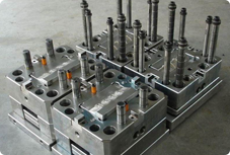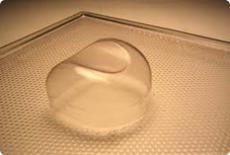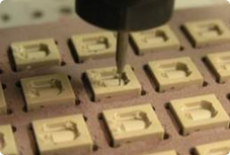Plastic
-

Plastic injection molding produces plastic parts by forcing molten plastic into a mold where it cools and hardens. In plastic injection molding granular plastic is fed by gravity from a hopper into a heated barrel. As the granules are moved forward by a screw-type plunger, the plastic is forced into a heating chamber, where it is melted. As the plunger advances further, the melted plastic is forced through a nozzle into the mold cavity. The mold remains relatively cold so the plastic solidifies almost as soon as the mold is filled. Custom steel tooling is required and adds to the initial cost but is quickly amortized.
Plastic injection molding provides low cost at moderate to large quantities. Plastic molding is an extremely versatile process for producing a wide range of simple or complex plastic parts with a good finish. Almost any 2D or 3D shape can be achieved. However draft is required in most cases as the shape must allow ejection from the mold. Side holes and even threaded holes are possible though they complicate the tooling. -

There are hundreds of different types of plastics you can cut and engrave for an extraordinary amount of applications. Generally speaking there are two different forms of plastics; thermosetting plastics that cure and set when heated and thermo softening plastics which melt when heated but can also be re-formed. Thermo softening plastics laser cut much more cleanly in most cases with a slightly polished edge. The only plastic we can’t cut is Polyvinyl Chloride (PVC) as the fumes aren’t very nice for humans or the machines! Key benefits laser cutting plastics
• Huge stock of engineering, sign and display plastics.
• Special order plastic engraving laminates.
• Special order non stock plastics, 1 -2 working days.
• Cut / vector engrave up to 2400mm x 1200mm. -

Plastics extrusion is a high volume manufacturing process in which raw plastic material is melted and formed into a continuous profile. Extrusion produces items such as pipe/tubing, weather stripping, fence, deck railing, window frames,plastic films and sheet, thermoplastic coatings, and wire insulation.
In the extrusion of plastics, raw thermoplastic material in the form of small beads (often called resin in the industry) is gravity fed from a top mounted hopper into the barrel of the extruder. Additives such as colorants and UV inhibitors (in either liquid or pellet form) are often used and can be mixed into the resin prior to arriving at the hopper. The process has much in common withplastic injection moulding from the point of the extruder technology though it differs in that it is usually a continuous process. While pultrusion can offer many similar profiles in continuous lengths, usually with added reinforcing, this is achieved by pulling the finished product out of a die instead of extruding the fluid raw material through a die. -

Vacuum forming is a simplified version of thermoforming, whereby a sheet of plastic is heated to a forming temperature, stretched onto or into a single-surfacemold, and held against the mold by applying a vacuum between the mold surface and the sheet. The vacuum forming process can be used to make most product packaging and speaker casings. It is also used to fabricate car dashboards. Vacuum forming is usually restricted to forming plastic parts that are rather shallow in depth. Thin sheets are formed into rigid cavities for unit doses of pharmaceuticals and for loose objects that are carded or presented as point of purchase items. Thick sheet is formed into permanent objects such as turnpike signs and protective covers. Normally, draft angles must be present in the design on the mold (a recommended minimum of 3°). Otherwise, release of the formed plastic and the mold is difficult.
-

The abbreviation CNC stands for Computer Numerical Control, especially referring to instructions used to control a mechanical device like a drill or cutter. CNC directs the tool to cut concise components by removing specific material.
The CNC machine cuts the mold and then plastic is injected. CNC Plastic Molding can also be called plastic injection molding. The mold is cut by a CNC drill and can be made up of any metal such as steel or aluminum. During the process of plastic injection molding, the plastic is heated till it melts, then is injected under pressure into a mold. The molten form is then allowed to cool down and set. When the plastic cools, it is taken out of the mold and the process is repeated.
It is very easy to change certain characteristics of the plastic like hardness and quality. The hardness of the final product depends on the pressure of the injection of the plastic into the mold. A good quality product depends on the thickness of the mold and the temperature for melting and cooling of the plastic.
An advantage to using CNC Plastic Molding is that it is very cost effective and fast. Also, this process rules out any undesired sharp edges and produces smooth and finished products that require no further finishing.






